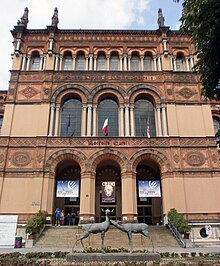Museo Civico di Storia Naturale di Milano
 | |
 | |
| Established | 1838 |
|---|---|
| Location | Corso Venezia, 55 - 20121 Milan, Italy |
| Director | Domenico Piraina |
| Website | Official website |
The Museo Civico di Storia Naturale di Milano (Milan Natural History Museum) is a museum in Milan, Italy. It was founded in 1838 when naturalist
The Museum is located within a 19th-century building in the
The museum is divided into five different permanent sections: Mineralogy (with a large collection of
The museum exhibits the largest Italian collection of over 100 full size
Mineralogy section

The mineralogy section showcases several minerals from all over the world including the world's largest
Paleontology section

The paleontology section explains the basics of paleozoology and paleobotany. Displays include fossils of several plants and animals. Among the most valuable pieces are a Spinosaurus snout, the skeletons of two pygmy elephants (Palaeoloxodon falconeri) from Sicily and the only existing fossil of the coelurosaurian theropod Scipionix samniticus. The museum also houses several other casts of dinosaur skeletons such as Allosaurus, Stegosaurus, Dromaeosaurus, Plateosaurus, and Stan (dinosaur), the fifth most complete Tyrannosaurus ever found.[4]
Natural history of man section
The natural history of man section is dedicated to the origins of
Invertebrate zoology section
The invertebrate zoology section is divided in two exhibitions. The first is about mollusks and arthropods: displays include a giant clam, which is the largest living bivalve, two Japanese spider crabs (male and female), Scolopendra gigantea, and arachnids like many spiders and scorpions from all over the world. The second exhibition is dedicated to entomology and displays many insects.[6]
Vertebrate zoology section

On the second floor of the building is the
The collection is notable for about 30 primary types of reptiles,[8] many of which have been described by the museum's first director, Giorgio Jan, who is also one of the most prolific herpetologists of all time with about 100 reptile species described.[9]
Directors

- 1838–1866 Giorgio Jan
- 1866–1882 Emilio Cornalia
- 1882–1891 Antonio Stoppani
- 1892–1911 Tito Vignoli
- 1911–1927 Ettore Artini
- 1928–1951 Bruno Parisi
- 1951–1964 Edgardo Moltoni
- 1964–1981 Cesare Conci
- 1981–1994 Giovanni Pinna
- 1994–2001 Luigi Cagnolaro
- 2001–2010 Enrico Banfi
- 2010–2012 Mauro Mariani
- since 2012 Domenico Piraina
Gallery
-
A Cro-Magnon skull from France
-
Pygmy elephant skeletons
-
ATyrannosaurus rex
-
Sperm whale skeleton.
-
Mounted polar bears in a diorama
See also
References
- ^ "Le esposizioni permanenti del Museo di Storia Naturale". Comune di Milano. Retrieved 2 January 2024.
- ^ Le città d'arte: Milano, Guide brevi Skira, ed. 2008, various authors
- ^ "Minerali". Museo di Storia Naturale di Milano. Retrieved 2 January 2024.
- ^ "Dinosauri e altri fossili". Museo di Storia Naturale di Milano. Retrieved 2 January 2024.
- ^ "Storia dell'Evoluzione Umana". Museo di Storia Naturale di Milano. Retrieved 2 January 2024.
- ^ "Invertebrati". Museo di Storia Naturale di Milano. Retrieved 2 January 2024.
- ^ "Animali vertebrati". Museo di Storia Naturale di Milano. Retrieved 2 January 2024.
- ISSN 1175-5334.
- ISSN 1175-5334.
External links
- Official website of the museum (in Italian)
 Media related to Museo civico di storia naturale (Milan) at Wikimedia Commons
Media related to Museo civico di storia naturale (Milan) at Wikimedia Commons











